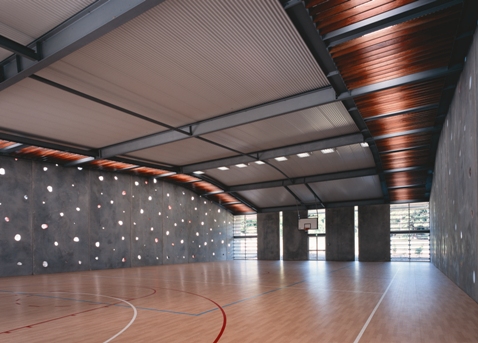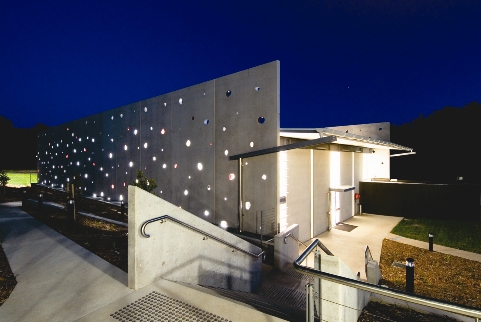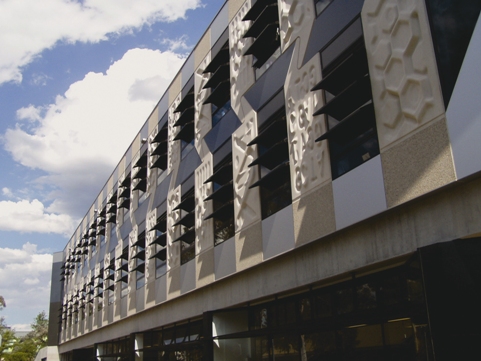Its fans say there are some pretty substantial benefits to be had by specifying prefab concrete solutions: it is said to provide a cost-effective, faster, higher-quality, sustainable solution.
Traditional prefab concrete applications would cover everything from floors, walls and claddings to structural components and stair cases. More recently uses have extended to the innovative perforated design at the Berry Sport and Recreation Centre in NSW, which also took advantage of other prefab benefits such as low-cost to win a World Architecture Festival award in 2009.
New technology, in both the design and manufacture perspectives, means an ever-expanding range of custom-designed options are emerging. The ultimate tool in design creativity and freedom coming about as architectural designs will transfer from a designers’ computer into the manufacturers.
Oddly enough, it is not the immense design possibilities which have provided the major impetus behind prefab concrete’s take-up of late. Instead it is the pressures of tough economic times, more so abroad than in Australia, which have had building industry focusing efforts to improve in efficiency and productivity.

The award-winning Berry Sport and Recreation Centre, designed by Allen Jack + Cottier, built by Ablock Builders. Photography Nic Bailey
New Zealand
PrefbaNZ was created in New Zealand in 2010 by a 140 strong group representing the interests of a wide range of materials and stakeholders in the design and construction sector. It includes clients through to designers, specifiers, manufacturers, contractors and government.
The official line was that there is a clear need for a radical paradigm shift to improve building quality in a sustainable way by decreasing defects, while also decreasing costs and timeframes. The industry decided that an increased uptake of prefabrication, with concrete playing a major part, would greatly benefit New Zealand’s wider design and construction industry.
The non-profit group’s ambitious mission is to double the uptake of prefabrication in NZ by 2020.
The United Kingdom
Hit harder by global and domestic recession, the UK campaign for prefab has moved into a prominent place in industry thinking. An industry-wide campaigning organisation named Buildoffsite, a very similar industry alliance to PrefabNZ, promotes the greater uptake of prefab, or offsite, techniques in UK construction.
Once again, the selling point is increased quality and productivity, and a reduction in building costs. Another reason the campaign has gained traction in the UK is thatgovernment’s greater advances in regulating for sustainable building. A recent report on the Future of UK Housebuilding, from RICS, the Royal Institute of Chartered Surveyors, put offsite production at the top of its list of the “rapid evolution of innovative technology” that will fulfil the time, cost, and sustainability requirements.
Australia
The time and cost savings are a major selling point in Australia as well, but according to National Precast Association Australia’s executive officer Sarah Bachmann, the sustainability benefits are yet to be understood by the majority of specifiers.
“It’s manufactured in a quality controlled environment, which means a better quality, more durable result. It also means safer worksites through less clutter and activity on site.”
“Because it’s manufactured in a factory, there is less wastage; unused material is recycled. And whether you’re dealing with wall panels, flooring, stairing, or whatever element, when it is placed on a site, there are no off-cuts of timber or blue-board, or concrete dags or other such waste: it arrives as the exact, finished element.
 The Berry project utilised technology by Hanson Precast
The Berry project utilised technology by Hanson Precast
When combined with Building Information Modelling (BIM) software, excess material procurement can be cut drastically.
The Australian Construction Industry Forum and the Australian Procurement and Construction Council are currently working together to create guidance documents to encourage collaboration early in the design process in order to maximise the benefits of offsite manufacture.
“Obviously it is very import to communicate early — that is architect, builder and precaster,” says Bachmann. “Early engagement by all parties means they can find the most effective way to design panels and projects. If the precaster is involved earlier, they can give guidance to architect on most efficient way to design, how to minimise costs and to ensure panels are transportable.”
“Added benefits might be that the designer learns of precast capabilities they were not aware of, for example they might be able to consider finishes they were not aware could be used.”
But according to Bachmann, what’s just over the horizon in terms of precast concrete design capabilities has not been given the attention it deserves. In particular, she refers to the transfer of non- traditional architectural designs which are converted by manufacturers software into moulds.
“It basically means that the only limit is your imagination,” she says.
 The John Curtin School of Medical Research was designed by Lyons with digitally rendered concrete panels expressing the research work done within
The John Curtin School of Medical Research was designed by Lyons with digitally rendered concrete panels expressing the research work done within
Looking forward
The emerging technology known as mass-customisation, or design for manufacture (DfMa), has been referred to as a 21st century take on the cookie-cutter design. Essentially, design software integrates with manufacturing software, and new machinery, including robotics, does the rest. Well, almost.
“We’re not quite there yet,” says Peter Webb, marketing manager at Hanson Precast, “but it will be exciting times when we resolve the challenge of getting the two sets of computer software and technology to talk to one another.”
Some of the projects that Hanson Precast has worked on are seen as precursors to the world of possibilities that are opening up in Australia.
Webb says the company’s current model has architects usually sending in 3D models, which are then converted into 2D shop drawings by the precaster. The scenario still sees some to-ing and fro-ing between architect and precaster. But it is a dramatic advance from the past.
“In older times, you’d need to have a master craftsmen or artisan come up with a pattern,” says Webb. “They’d take a piece of timber and spend weeks carving a pattern. Then they might go backwards and forwards with the architect making adjustments.”

